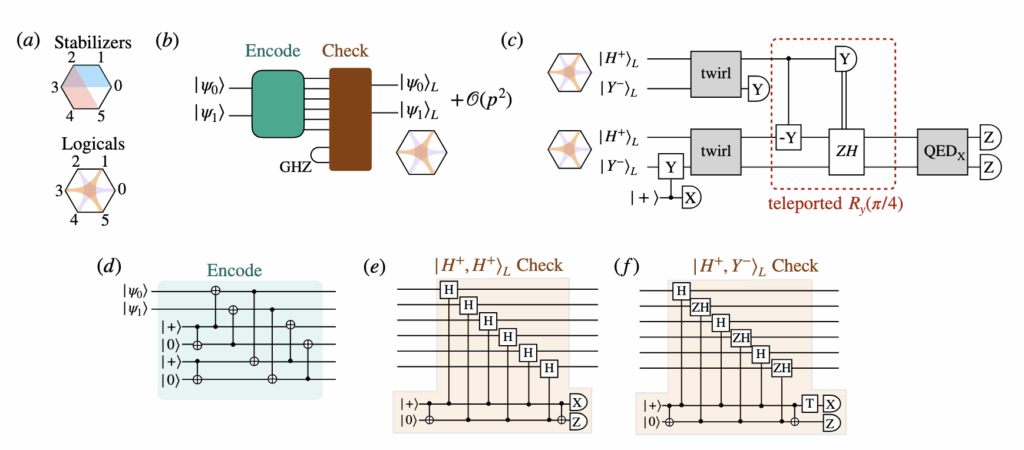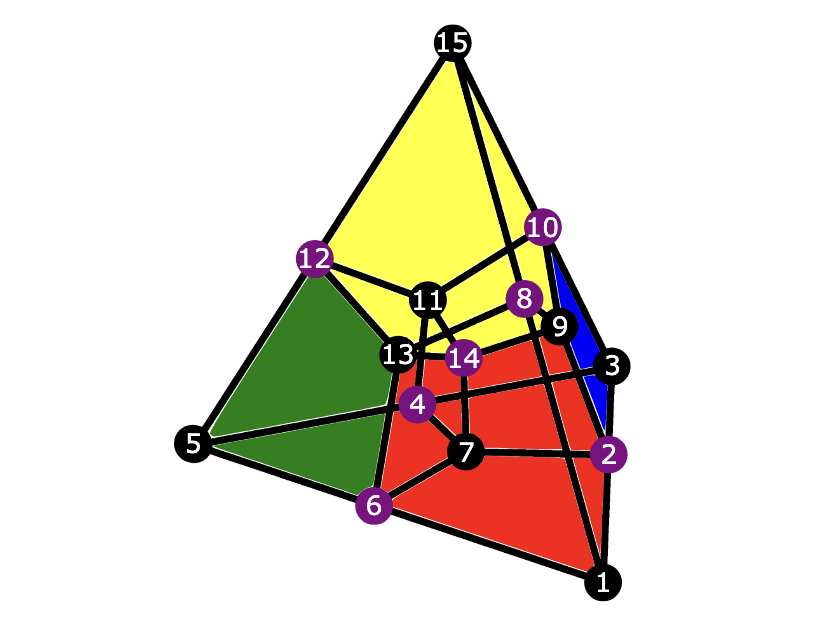Insider Brief
- Quantinuum reports it has achieved the first universal, fully fault-tolerant quantum gate set with repeatable error correction, a milestone the company calls essential for delivering scalable quantum computers by 2029.
- Two new studies demonstrate record-setting fidelity in magic state production and fault-tolerant non-Clifford gate execution, with logical error rates surpassing those of physical gates.
- The results validate techniques such as code switching and compact error-detecting codes, which could reduce qubit overhead and accelerate timelines for industrial-scale quantum applications.
Quantinuum writes in a company blog post and two new research papers that it has taken a leap over what the company describes in its blog as “the last major hurdle to deliver scalable universal fault-tolerant quantum computers by 2029”.
Researchers report they demonstrated — for the first time — a universal gate set that is fault-tolerant and scalable. In the pair of technical papers posted to the pre-print server arXiv, the company presents experimental evidence for a critical capability long sought by the quantum industry: the ability to perform any quantum operation while detecting and correcting errors throughout the entire computation process.
To scale beyond proof-of-concept experiments and reach industrially useful applications, quantum computers must be both universal and fault-tolerant. Universality ensures that any computational task can be performed, while fault tolerance is required to manage the errors that are endemic to quantum systems. Until now, no organization had demonstrated all the components of such a system operating with high enough fidelity to be viable, according to the post.
“Quantinuum is the first — and only — company to achieve this critical technical breakthrough, universally recognized as the essential precursor to scalable, industrial-scale quantum computing,” the team writes in the post “This milestone provides us with the most de-risked development roadmap in the industry and positions us to fulfill our promise to deliver our universal, fully fault-tolerant quantum computer, Apollo, by 2029. In this regard, Quantinuum is the first company to step from the so-called “NISQ” (noisy intermediate-scale quantum) era towards utility-scale quantum computers.”
Fault-Tolerant Computing’s Core Elements
Quantinuum’s new work focuses on two core elements of fault-tolerant computing: magic state distillation and code switching. The company says its results mark the first time a fully fault-tolerant non-Clifford gate — an operation essential for universal quantum computing — has been implemented at logical error rates lower than those at the physical level.
In the first paper, Quantinuum reports achieving a new record in magic state fidelity, a benchmark for the quality of a resource state needed to perform non-Clifford operations. Using a two-code hybrid protocol on its H2 system, the team reached an error rate of 5.1×10⁻⁴ — well below previously reported results. The new protocol is compatible with the company’s existing architecture for scaling quantum error correction and is projected to reach even lower error rates with future hardware improvements. (Please see the section below for a more complete summary of the paper.)
The company writes in the post that this achievement constitutes the first experimental realization of a “break-even” non-Clifford gate — one that performs better at the logical level than the underlying physical gate. To break this down, physical gates are the raw operations performed on the hardware, but they’re error-prone. Logical gates are error-corrected versions built from multiple physical gates. Quantinuum’s result shows that the corrected version actually outperforms the uncorrected one and that’s evidence that error correction is working as intended.
This work addresses a central challenge in quantum error correction: reducing logical error rates to levels below those of the underlying hardware without incurring unsustainable overheads in qubit count or time.
In the second study, conducted in collaboration with researchers at the University of California, Davis, Quantinuum demonstrates a fault-tolerant non-Clifford gate using only eight qubits. The team implemented a compact error-detecting code and a controlled-Hadamard operation that beat the physical gate’s own fidelity. This approach, lean and scalable, may accelerate development of more efficient magic state factories. (Please see the section below for a more complete summary of the paper.)
A Toolkit For Fault Tolerance
Together, the two papers establish a toolkit that meets the theoretical threshold for fault-tolerant universality. The company says these innovations will significantly accelerate timelines for industrial quantum applications, as many current performance forecasts are based on inefficient error-correction codes. With more optimized protocols, the number of qubits needed for real-world algorithms could drop by an order of magnitude or more.
Quantinuum plans to integrate these techniques into its upcoming Helios processor, a 98-qubit machine aimed at running fully fault-tolerant algorithms. According to internal simulations, the system could support error rates as low as one in ten billion, depending on the continued improvement of physical qubit fidelity. The company anticipates that future versions could push error rates as low as one in ten trillion.
While other firms and academic teams have demonstrated fault-tolerant operations in limited settings, these efforts have typically been constrained to small numbers of qubits or yielded low-fidelity results — often with logical error rates around 10%. Quantinuum’s approach, by contrast, claims both scale and performance, and appears to be the first to assemble a complete high-fidelity gate set.
With industrial-grade fault tolerance seen as a precondition for quantum advantage in applications like chemistry, optimization, and materials discovery, the availability of a universal gate set marks a critical turning point. Quantinuum’s next steps will likely involve verifying these findings. The company also suggests as next steps that it will integrate this gate set into practical algorithms and demonstrate full-stack quantum computations that outperform classical systems on meaningful tasks.

Research Paper 1: Quantinuum Delivers Break-Even Non-Clifford Gate with Minimal Overhead
(Breaking even with magic: demonstration of a high-fidelity logical non-Clifford gate)
Quantinuum has experimentally demonstrated a fault-tolerant non-Clifford gate with logical error rates lower than the best available physical equivalents in this paper. This has been a critical boundary in quantum computing. Using only eight qubits, the team prepared two logical magic states inside a compact error-detecting code, then used those states to perform a controlled-Hadamard (CH) gate with an error rate significantly lower than what is achievable with unencoded, physical gates. The small qubit count — 8 qubits — suggests the method is lean, scalable, and well-suited to near-term devices.
The method builds on ideas from “zero-level distillation,” adapting them to the H6 [[6,2,2]] quantum error-detecting code. This is a compact error-detecting scheme that uses six physical qubits to encode two logical qubits and can detect, but not correct, any single error—allowing efficient fault-tolerant operations with minimal hardware.
The protocol uses a special verification process to detect and discard faulty attempts before the actual gate operation, leading to reliable performance without the need for full-scale distillation routines. The prepared states had a measured infidelity of just 7×10⁻⁵, with a discard rate of about 15%. These results were obtained on Quantinuum’s H1-1 trapped-ion quantum processor.
Once prepared, the magic states were used to implement a CH gate between two logical qubits. As background, a controlled-Hadamard gate is a two-qubit operation that works like a conditional switch. It tells one qubit to enter a superposition—a quantum blend of 0 and 1—but only if the other qubit is in the “on” state. This kind of conditional behavior is essential for running complex quantum programs.
The resulting gate had a logical error rate no higher than 2.3×10⁻⁴ — well below the physical CH gate’s baseline error of 1×10⁻³. This represents the first time a non-Clifford gate has been implemented fault-tolerantly with logical fidelity better than the best physical gate of the same type. For fault-tolerant quantum computing, this “break-even” moment is critical, proving that logical operations can outperform their unprotected physical counterparts.
In addition to single-gate benchmarking, the researchers ran a sequence of logical Ry(π/4) rotations to test gate stability over multiple applications. The fidelity remained within acceptable thresholds, demonstrating the robustness of the approach. Simulations suggest that this method can be self-concatenated to produce higher-distance codes capable of pushing error rates as low as 10⁻¹⁴ while using approximately 40 physical qubits per magic state.
The paper also explores future integration pathways, including transferring magic states into more complex error-correcting codes via level-raising teleportation. This approach balances space and time costs while providing the high fidelity required for advanced quantum algorithms. When scaled, the method could drastically reduce the overhead of magic state factories, long considered one of the main bottlenecks for practical quantum computing.
This study was conducted by researchers at Quantinuum’s facilities in Broomfield, Colorado, and Cambridge, UK, in collaboration with the Department of Computer Science at the University of California, Davis. It was posted to arXiv in June 2025.

Research Paper 2: High-Fidelity Magic States Surpass Break-Even Threshold
(Experimental demonstration of high-fidelity logical magic states from code switching)
In this paper, Quantinuum researchers demonstrate that it is now possible to prepare high-fidelity magic states that outperform the physical operations used to create them. The study reports experimental results that show a logical error rate at least 2.9 times better than the best available physical benchmarks, achieving what is known as the “break-even” point.
In other words, Quantinuum has shown it can create special quantum states — which quantum experts refer to as magic states — using an error-correcting process that makes them more accurate than the raw operations used to produce them. This means their method doesn’t just patch over hardware flaws. Rather, it actually improves the quality of quantum operations beyond what the physical system can do on its own.
The experiment used a hybrid technique that involved preparing the magic state within a two-dimensional color code and transferring it into another code — specifically, a Steane codeblock — via a method called code switching. This method sidesteps long-standing limitations on non-Clifford gates. Traditional approaches typically require multiple rounds of error-prone distillation. Here, however, Quantinuum’s protocol relied only on verified pre-selection steps before the main computation began, reducing complexity while preserving fidelity.
The fidelity of the resulting logical magic state was measured at a minimum of 0.99949, equivalent to an infidelity of 5.1×10⁻⁴. These numbers were obtained using a rigorous two-stage verification method. In the first stage, the team performed single-copy measurements using quantum state tomography. In the second, they used a Bell basis measurement — an efficient sampling technique requiring two magic states — to estimate the purity of the quantum state. The combined approach yielded an error estimate well below that of any previously published method using similar or even more elaborate resources.
The results were obtained using Quantinuum’s H2-1 trapped-ion processor and involved 28 qubits for the single-copy and 56 qubits for the two-copy experiments. These high-fidelity states are crucial not just for demonstrating a key gate operation, but also for feeding larger fault-tolerant algorithms in chemistry, physics, and optimization problems. Notably, the performance of this protocol enables a single round of distillation to push error rates below 10⁻⁸ — potentially making this the last distillation step needed for certain applications.
The team also reports that by adding post-selection — discarding outcomes that show any sign of error — they were able to further improve the magic state fidelity, although this step introduces trade-offs in scalability. Nonetheless, the baseline protocol already performs better than previous results, including those that rely heavily on post-selection.
This study was conducted by researchers from Quantinuum in Colorado, the Department of Physics and Astronomy and Department of Computer Science at the University of California, Davis, and Sandia National Laboratories.




0 Comments